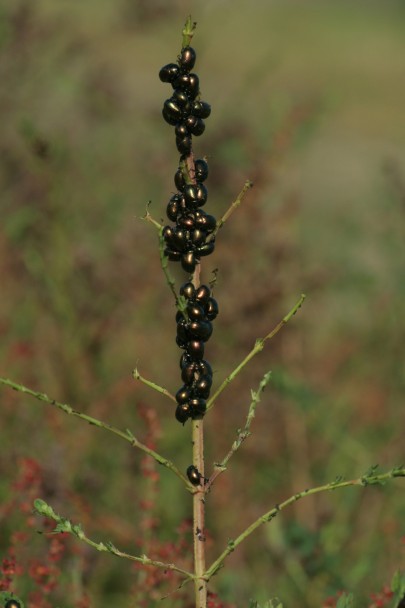
St John's wort beetles (Chrysolina hyperici) on plant
In AoNZ infestations of St John’s wort were particularly serious in hill country dryland farms, reducing the productivity of pasture and poisoning livestock into the bargain. The plant was a toxic scourge, and its seeds were widely transported around the country, especially in roading gravel. Now it clings on in pasture as a minor weed only in a few parts of Otago.
Where did all the St John’s wort go? Our farmers’ reprieve is all thanks to weed biocontrol – the release of two beetles with very specific dietary requirements – and a fair amount of patience.
The lesser St John’s wort beetle (Chrysolina hyperici) and the closely related greater St John’s wort beetle (Chrysolina quadrigemina) were released in AoNZ in 1943 and 1965, respectively, and quickly set about their work. Only 4 years after release the lesser St John’s wort beetle, alone, had cleared over 180 hectares of the weed in the Marlborough district, and today, it’s all but gone.
But what if nothing had been done?
Recently, two of our weed biocontrol researchers, Dr Simon Fowler and Dr Ronny Groenteman, along with informatics specialist James Barringer and Dr Grant Humphries (Black Bawks Data Science Ltd, Scotland), revisited the history books to do a retrospective economic analysis of this flagship biocontrol project.
“The analysis was multifaceted, pulling together predictions on expected modern-day geographical range and the past spread of St John’s wort, data on economic losses caused by St John’s wort, and annual investment in weed biocontrol research, all cost-adjusted for the year 2022,” explains Simon.
The starting point was to estimate the spread of St John’s wort by 2022 if biocontrol had never begun. The expected range of the weed for the present day across South Island hill country was simulated using ecological niche modelling and GIS mapping of land use. Overall, 660,000 ha was the final area of potentially highly infested pasture, which would have been reached since 1989 in the absence of biocontrol.
Next, production losses were calculated using stocking rate data for South Island sheep farms, along with estimates of how much pasture would have been displaced by the weed. It was conservatively assumed that farmers would make control efforts, but with serious infestations would still have lost 30% of their productive land to St John’s wort.
Overall, the economic analysis predicted that total annual losses to South Island farmers from St John’s wort in the absence of biocontrol would have been $119,000 per annum in 1940, increasing to $15.7 million per annum by 2022. Allowing for the cost of developing the biocontrol programme, this translates to savings of $15.5 million per annum. To put this saving in perspective, AoNZ’s current annual investment in all weed biocontrol is around $1.34 million, just 9% of the ongoing annual benefit from the St John’s wort biocontrol programme alone. Put another way, AoNZ has gained $6,254 for every $1 invested in the beetles – which is a great return, to put it mildly.
Control of St John’s wort is now completely self-sustaining. Over about 50 years the plant has been gradually ‘winking out’ across the hill country, according to Simon, as the beetles systematically find and destroy any emerging patches. “Of course, the benefit that we continue to get from biocontrol of St John’s wort can be easily overlooked when we are no longer confronted with it as a weed problem,” he adds. “But in the long run, this has been a phenomenal success.”

